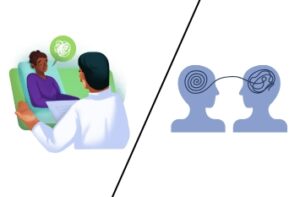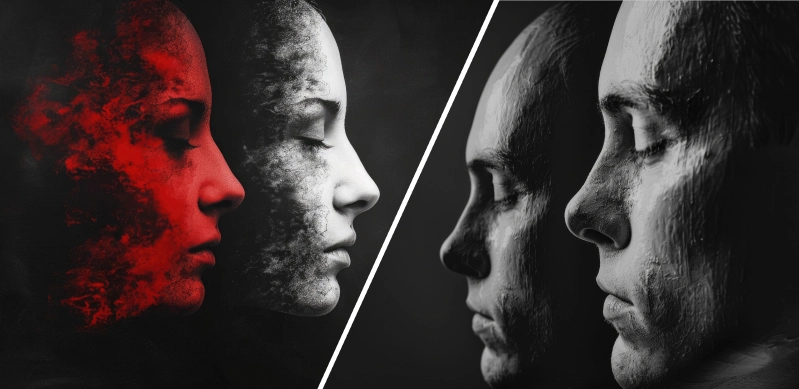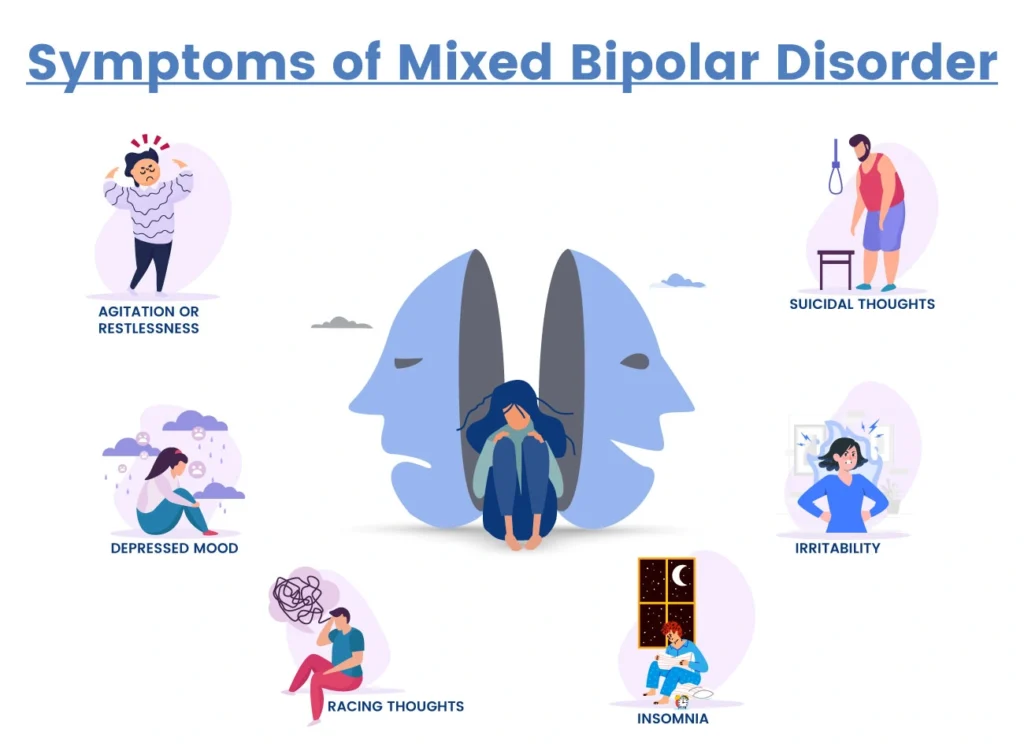
Counseling vs. Therapy: What’s the Difference, and Which One Do You Need?
Counseling vs. Therapy: What’s the Difference, and Which One Do You Need? When You’re Ready to Seek Support When you’re ready to seek support for

Have you ever felt like your emotions were a whirlwind, where intense highs and crushing lows collided all at once? This overwhelming experience is what happens during a mixed bipolar disorder episode. It’s a mental health condition where symptoms of mania and depression occur simultaneously, making it a challenging and often confusing state of mind.
Mixed bipolar disorder doesn’t discriminate; it can affect anyone regardless of age or gender. This is a serious condition that typically requires professional treatment, guidance, and support to navigate safely.
A mixed episode bipolar is a phase within bipolar disorder where symptoms of both mania and depression occur simultaneously or in rapid succession. Unlike typical bipolar episodes that are distinctly manic or depressive, a mixed episode creates a blend of both extremes, leading to a chaotic and often distressing mental state.
During a mixed episode, a person might feel energized yet hopeless or agitated while experiencing intense sadness. This combination of symptoms can be particularly dangerous, as the high energy levels associated with mania paired with depressive thoughts may increase the risk of self-harm.
Mixed state bipolar is a complex and challenging phase of bipolar disorder where an individual experiences symptoms of both mania and depression simultaneously. Unlike the more typical episodes where the mood shifts from one extreme to another, a mixed state blends these opposing emotions together.
For example, someone might feel a surge of energy or restlessness (a hallmark of mania) while also grappling with feelings of despair or hopelessness (symptoms of depression). This duality can be incredibly distressing and confusing, making it difficult for the person to understand or control their emotions.
Recognizing a mixed state bipolar is key to seeking appropriate treatment and support, as this condition can significantly impact one’s daily life and overall well-being.
Bipolar disorder mixed episodes can affect anyone, regardless of age, gender, or background. While the condition is typically diagnosed in late adolescence or early adulthood, it can develop at any stage of life. Certain factors, such as genetics, brain chemistry, and environmental stressors, may increase the risk of experiencing mixed episodes.
Key factors include:

The symptoms of mixed bipolar disorder are a complex blend of both manic and depressive features, occurring simultaneously or in rapid alternation. This condition can be particularly overwhelming, as the opposing symptoms intensify each other, creating a chaotic emotional state.
A person might feel highly energized yet profoundly sad or irritable while struggling with feelings of worthlessness. This overlap makes it difficult to find relief, as the typical coping mechanisms for one type of episode may exacerbate the other.
The exact causes of mixed episode bipolar disorder are not entirely understood, but it is believed to result from a combination of genetic, biological, and environmental factors.
Research suggests that abnormalities in brain chemistry, particularly involving neurotransmitters like serotonin, dopamine, and norepinephrine, play a significant role in mood regulation. Additionally, a family history of bipolar disorder or other mood disorders increases the likelihood of developing mixed episodes.
Stressful life events, trauma, and substance abuse can also act as triggers, pushing someone into a mixed state. Understanding these causes can help in managing and preventing the occurrence of mixed episodes.
Genetics are a major factor in the development of bipolar disorder, including mixed episodes. Individuals with a family history of bipolar disorder are more likely to experience these episodes. Studies suggest that multiple genes, rather than a single gene, contribute to the disorder, affecting brain function and mood regulation.
Abnormalities in brain chemistry, particularly involving neurotransmitters such as serotonin, dopamine, and norepinephrine, are closely linked to bipolar disorder. These chemicals are responsible for regulating mood, and imbalances can lead to the extreme mood swings characteristic of mixed episodes.
Environmental factors, including significant life stressors, trauma, or major changes in life circumstances, can trigger mixed episodes in those predisposed to bipolar disorder. Substance abuse and poor sleep patterns are also known to exacerbate symptoms, making the management of these factors crucial in preventing episodes.
Hormonal fluctuations, especially during periods such as puberty, pregnancy, or menopause, can contribute to the onset of mixed bipolar episodes. These changes can affect mood stability, potentially triggering episodes in vulnerable individuals. Managing hormonal health is often a part of the overall treatment strategy for bipolar disorder.
Bipolar mixed episodes come with significant risks due to the simultaneous presence of manic and depressive symptoms. The combined effects of high energy and profound sadness can lead to severe emotional instability and dangerous behaviors.
Individuals experiencing mixed episodes are at a higher risk for self-harm or suicidal actions, as the intense emotional conflict can be overwhelming.
Increased risk of self-harm or suicide: The emotional turmoil from mixed symptoms can lead to severe self-destructive thoughts or actions.
Impaired judgment: The conflicting emotions can lead to reckless behavior and poor decision-making.
Relationship difficulties: Erratic mood swings can strain personal and professional relationships.
Work or academic challenges: The instability can impact performance and reliability in work or school settings.
Substance abuse: The desire to manage or escape intense emotions may lead to increased use of alcohol or drugs.
Distinguishing between a borderline personality disorder episode and a bipolar mixed episode can be challenging due to overlapping symptoms, but there are key differences. Borderline personality disorder (BPD) is characterized by unstable moods, self-image, and interpersonal relationships, often resulting in impulsive actions and intense emotional swings.
Aspect | Borderline Personality Disorder (BPD) | Bipolar Mixed Episode |
Mood Stability | Rapid and intense mood swings, often triggered by interpersonal issues | Simultaneous presence of manic and depressive symptoms |
Emotional Regulation | Difficulty with emotional regulation, leading to impulsive behaviors | Emotional turbulence with both high energy and profound sadness |
Duration | Mood swings are often short-lived and linked to external stressors | Episodes can last for days or longer, involving persistent mixed symptoms |
Self-Image | Instability in self-image and identity, often leading to self-harm | Self-image issues may arise but are typically not central to the mixed episode |
Relationships | Intense, unstable relationships with fear of abandonment | Relationships may be strained due to mood swings, but not primarily characterized by relational instability |
Triggers | Often triggered by interpersonal conflicts or perceived rejection | May not be directly linked to specific interpersonal events |
Treating bipolar episodes with mixed features requires a multifaceted approach that addresses both the manic and depressive symptoms simultaneously. Effective treatment often involves a combination of medication, therapy, and lifestyle adjustments to help stabilize mood and improve overall functioning.
It’s essential for individuals to work closely with healthcare professionals to develop a personalized treatment plan that can manage the complexities of mixed episodes.
Medications are often the cornerstone of managing mixed bipolar episodes. A combination of mood stabilizers, antipsychotics, and sometimes antidepressants may be prescribed to balance mood swings and alleviate symptoms. Regular monitoring is crucial to adjust dosages and avoid potential side effects.
Psychotherapy plays a vital role in helping individuals understand their condition and develop coping strategies. Cognitive-behavioral therapy (CBT) and dialectical behavior therapy (DBT) are commonly used approaches to address the emotional and behavioral aspects of mixed episodes.
Incorporating lifestyle changes can significantly impact the management of mixed bipolar episodes. Regular exercise, a balanced diet, and adequate sleep contribute to overall mood stability and well-being.
Building a strong support system is essential for managing bipolar episodes. Engaging with family, friends, and support groups can provide emotional support and practical assistance in navigating daily challenges.
Managing a bipolar mixed episode involves a comprehensive approach that integrates medication, psychotherapy, lifestyle changes, and strong support systems. Understanding the unique challenges posed by the simultaneous presence of manic and depressive symptoms is crucial for effective treatment and improved quality of life.
By addressing these episodes with tailored strategies and professional guidance, individuals can work towards stabilizing their mood and reducing the impact on their daily lives.
Question 1: Is there a pattern in bipolar episodes?
Ans: Bipolar episodes often follow a cyclical pattern, but the frequency and duration can vary widely among individuals. Many people experience a series of manic and depressive episodes over time, with periods of stability in between. These cycles can range from a few weeks to several months.
Question 2: Can bipolar turn into schizophrenia?
Ans: Bipolar disorder and schizophrenia are distinct mental health conditions, though they share some overlapping symptoms, such as delusions and hallucinations. Bipolar disorder does not “turn into” schizophrenia, but some individuals may develop symptoms of schizophrenia or a related disorder if their bipolar disorder is not well managed.
Question 3: What do bipolar delusions look like?
Ans: Delusions in bipolar disorder, particularly during manic or mixed episodes, often involve grandiose beliefs or paranoia. For example, an individual might believe they have special powers or an important mission, or they might feel that others are plotting against them. These delusions are typically intense and can significantly impact daily functioning and relationships.
Question 4: How long does a bipolar psychotic episode last?
Ans: The duration of a bipolar psychotic episode can vary, but it generally lasts from a few days to several weeks. The length of the episode can be influenced by the individual’s treatment and management of their bipolar disorder. Effective medication and therapy can help reduce the duration and severity of psychotic episodes, leading to quicker stabilization and recovery.

Counseling vs. Therapy: What’s the Difference, and Which One Do You Need? When You’re Ready to Seek Support When you’re ready to seek support for
